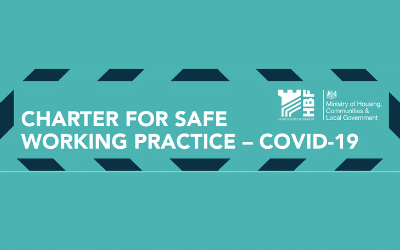
by Iain McIlwee | 16 Jul, 2020 | Main News Feed, Transformation
Led by the Construction Leadership Council and supported by a Government-backed R&D programme, the Construction Innovation Hub is working with Government and leading industry bodies from the Construction sector to develop a new ‘Value Toolkit’ intended to help policy makers and clients make faster, informed decisions which incentivise industry to respond with innovative, high value solutions.
The Toolkit will support better decision-making throughout the whole investment lifecycle from business case through to procurement and delivery and operation, improving overall sector performance consistent with key policy objectives such as driving Modern Methods of Construction (MMC), delivering social impact and accelerating the path towards Net Zero.
Announced today as part of UK Research and Innovation’s Future of Building Week, the new Toolkit contains a suite of tools in four linked modules which will:
- Support policy makers, clients and advisors in defining the unique value profile for a given project and create value indices through which informed decisions can be made;
- Help clients and their advisers to select a delivery model and commercial strategy, and industry to develop business models, that best meet the value drivers of the project;
- Build on the groundwork laid by Ann Bentley and the Construction Leadership Council Procuring for Value Working Group and the IPA’s Transforming Infrastructure Performance to allow clients make procurement decisions based on the value drivers of the project and industry to shape their offers accordingly; and,
- Continuously forecast and measure value performance throughout delivery and operation, helping clients and industry to maximise value on each project and using performance data to help policy makers shape decisions on future projects.
Construction Innovation Hub Programme Director Keith Waller said:
“With the CLC Roadmap to Recovery and the supportive measures recently announced by the Prime Minister and Chancellor, the starting gun on sector recovery has well and truly been fired. It is crucial however, that we don’t lose sight of the bigger prize here – the opportunity to embed a lasting shift towards value-based decisions that drive better social, economic and environmental outcomes.
“By abandoning, once and for all, our sector’s historic affinity with cheapness and embracing a new model where delivering value drives our decision-making, we can ensure that UK construction is actively supporting the path to Net Zero, boosting productivity, delivering safe, higher quality buildings, improve social impact, supporting regeneration, levelling up and much more.
“As well as making better decisions, our Toolkit will ensure we make them faster, ensuring industry can deliver on the Government’s vital ‘Project Speed’ ambitions to stimulate our economy.
“For this to deliver real and lasting impact however, support and buy-in from policy makers, clients and industry at large is crucial. We are very fortunate to have strong support from some of construction’s leading voices like ACE, CE, CECA, CLC, as well as the Responsible Authorities we announced last week to take this crucial package of work forward.”
UK construction could soon be on the verge of a fundamental shift towards value-based decision making, thanks to a flagship initiative unveiled today by the Construction Innovation
Minister for Business and Industry, Nadhim Zahawi MP said:
“This brilliant new initiative reflects the Government’s desire to ensure we embrace a construction procurement process that has clean, green innovation at its heart.
“It complements our commitment to boost the productivity of this vital industry as part of our economic recovery. I look forward to working with the Construction Innovation Hub and Construction Leadership Council to realise this ambition.”
Iain McIlwee, Finishes and Interiors Sector CEO added:
“This Toolkit flags that there is another way, construction doesn’t have to be a Dutch Auction all about price, it has to move away from ‘building units’ at lowest cost, but ‘making places’ if we truly want the UK to be the most attractive place to live and to invest and to set up a company. To do this we have to understand where the value is, how to measure that value and the impact that our decisions through the construction process have on enhancing, maintaining or destroying that value”
- Download the Report – An Introduction to the Value Toolkit HERE
Additional information:
- The Construction Innovation Hub was launched in November 2018 and brings together world-class expertise from the Manufacturing Technology Centre (MTC), BRE and the Centre for Digital Built Britain (CDBB) to transform the UK construction industry. With £72 million from UK Research and Innovation’s Industrial Strategy Challenge Fund, the Hub aims to change the way buildings and infrastructure are designed, manufactured, integrated and connected within our built environment.
www.constructioninnovationhub.org.uk
- Key industry partners are supporting the development of the Value Toolkit as follows:
- Ann Bentley is leading on the Value Definition element of the Toolkit (in support of the sector deal ask for a consistent definition of value), drawing on the expertise contained within the CLC’s procuring for Value working group and building a consensus based approach via a Relevant Authorities model (i.e. groups of subject matter experts headed by key industry organisations – one for each capital);
- The Association for Consultancy and Engineering (ACE) has assembled a team of industry experts together to lead work on delivery models, commercial strategies;
- Constructing Excellence (CE) is drawing on its extensive membership to engage with the supply chain (consultants, contractor and manufacturers) to understand levels of capability and to identify and address key barriers to the adoption of value-based approaches;
- The Civil Engineering Contractors Association (CECA) is working directly with the Hub to address skills and training needs required to bring clients and industry on the journey and helping us plot a path to widespread adoption; and,
- The Infrastructure and Projects Authority (IPA) is leading a client advisory group of key public (TIP+MHCLG) and private clients to ensure we create something that is implementable and which aligns with and enhances (on the public side) existing procurement policy (green book rules) and decision-making processes.
- Relevant Authorities are chaired by key industry organisations who perform the role of custodians for each capital. The relevant authorities have responsibility for selecting and refining the metrics, measures and scoring profiles for each value category, working directly with input from clients/asset classes. The Hub’s dedicated team will embed the outputs of the RA’s into the methodology and tool. In the longer term, RA’s will also be responsible for benchmarking and analysis of submitted data. The Relevant Authorities are: RICS, RIBA, CIOB and Social Value UK

by Iain McIlwee | 16 Jul, 2020 | Main News Feed
FIS has raised concerns with officials from The Department of Business Energy and Industrial Strategy (BEIS) that interior systems installers have not been included as an eligible occupation for the skilled worker route in the outline plans for a UK Points Based Immigration System post Brexit.
A new points‐based immigration system which will apply to EU and non‐EU citizens and require those that want to work in the UK to meet a specific set of requirements. In addition to passing the relevant UK criminality checks, the job must have a salary of at least £20,480, and 50 points are ‘earned’ by meeting the following mandatory criteria:
- The applicant must have an offer of a job from a licensed sponsor
- The job must be at or above the minimum skill level: RQF3 level or equivalent (A level or equivalent qualification). Workers will not need to hold a formal qualification; it is the skill level of the job they will be doing which is important
- The applicant must speak English to an acceptable standard.
An additional 20 points can be gained through a combination of a higher salary, a job being on the shortage occupation list, and/or the holding of additional qualifications.
Drylining, for example, is intrinsic to most construction and house building projects and has a significant impact on the time frames for completing work – there are approximately 45,000 CSCS card holding dry liners (this does not include overlapping trades that undertake drylining work, but carry an alternative card). As at January 2020 FIS members reported 42% of their workforce was made up of immigrant labour.
Although English Training Providers are preparing to deliver training for the latest Apprenticeship Standard, in drylining, the numbers will not provide the level of the existing labour pool for at least two years. However, this will ensure future, home grown, dryliners are competent.
Despite the number of dry liners now exceeding many of the more traditional trades, it has historically been lost in “Construction Operatives Not Elsewhere Classified (8149)” within the Office of National Statistics (ONS) Sector Occupational Classification (SOC) Codes, as are ceilings and partitions installers and a raft of other specialist trades. The Codes are used to collect and provide statistical data on occpations. This latest report on the UK Points Based Immigration System has been based on the Office of National Statistics (ONS) 2010 Sector Occupational Classification (SOC) Codes. In 2020 these were revised and, due to the close link between Drylining and Plastering, it is now officially listed under 5321 “Plasterers” (which is classified as an Eligible Occupation for the Skilled Worker Route). The trades are closely aligned, many companies will offer both options for finishing and elements of drylining finishing are currently included within the plastering apprenticeship standard.
Commenting on the report, FIS CEO Iain McIlwee stated; “we recognise that within these plans some positive movement has taken place based on the research we supported on Shortage Occupations published last year and several meetings and round table events that we participated in with various Government Departments. At this stage I remain convinced that this is an oversight and as plans evolve into policy we can make the necessary adjustments. We continue to work with BuildUK, The Department of Building Energy and Industrial Strategy, CITB and colleagues at the Home Office and Migration Advisory Committee (MAC) to this end – we will also be picking up concerns (as a sector that relies on around 60% of our workforce as Labour Only Subcontractors) that the system does not rely on impractical employment expectations.
One thing we must reinforce is that drylining is a skilled trade intrinsic to modern construction. FIS exists to help raise standards in the construction sector and continue to dedicate resources through schemes like BuildBack to promote and encourage ‘home grown talent’ and ensure that all working in the UK, whether immigrant of domestic worker are competent to complete their work and that their skills and knowledge of the materials, environment and processes are kept current. This is ongoing and within this we need to avoid a real cliff face for the sector that will have serious ramifications for the wider construction and housebuilding market.”
You can view the outline plans for a UK Points Based Immigration System.
FIS has prepared an overview paper based on concerns with the proposed UK Points Based Immigration System here.
If you have any comments, please email georgeswann@thefis.org

by Clair Mooney | 15 Jul, 2020 | Main News Feed
HBF Wales, in conjunction with the Welsh Government has launched a house building Site Safety Charter to help construction sites reopen in line with latest health and safety guidance.
House builders are gradually returning to work after a three month layoff as a result of the coronavirus crisis.
The document demonstrates a commitment from housebuilders and the wider industry to safe working whilst Covid-19 remains prevalent as well as government support for the resumption of house building and sales activity. Stimulating house building activity can play a major part in supporting an economic recovery – as well as ensuring the supply of desperately needed new homes is maintained.
The intention is that house builders will display the Charter on their sites, reinforcing their commitment to safe working and helping reduce concerns that their workforce, neighbours and customers may have at the current time.
The charter aligns with the Welsh Government’s Coronavirus Regulations and Moving home during the coronavirus pandemic Guidance and the Workplace guidance for employers and employees: COVID19 and has been developed in agreement with CHC Community Housing Cymru and FMB Cymru Federation of Master Builders Cymru.
Stewart Baseley, Executive Chairman of the Home Builders Federation, said:
“Over recent weeks house builders have commenced a gradual return to work, in a structured way that ensures the safety of its workforce and the general public.
“The industry sustains thousands of people in numerous roles and associated sectors, boosting local economies across Wales. A resumption of work will play a major part in helping the economy recover as well as delivering the homes the country needs.
“It should also provide the supply chain with the confidence it needs to accelerate its own restart. The Charter is the public facing evidence which supports the very detailed protocols individual builders now have in place to ensure safe working on sites.”
Minister for Housing and Local Government, Julie James said:
“The need for a secure, safe and affordable home has never been more apparent than during the coronavirus pandemic.
“The contribution of the construction industry to creating more of these homes and the economy has also been highlighted during the crisis. This is why restarting work on building these homes in a safe and controlled manner is vital. This safe working charter will help the construction industry and the social landlords that contract them to do just that.
Aaron Hill, Head of Policy and External Affairs at Community Housing Cymru said:
“The coronavirus pandemic has demonstrated the importance of good quality, affordable homes, and the need for investment in housing to play a key part in the economic recovery in Wales and beyond.
Housing associations have worked tirelessly to maintain a safe working environment throughout this period, and we are pleased to be supporting this charter which will protect the wellbeing of all those who are required to be on construction sites. This charter will play a key part in ensuring sites can operate safely as we work together to deliver the homes Wales needs.”
Ifan Glyn, Director of the Federation of Master Builders (FMB) Cymru said:
“Getting back to building new homes to ensure that we meet housing demand is of course of great importance, but what is more important still is that we do so without jeopardising the sacrifices made to contain the virus during the lockdown period. We, the Federation of Master Builders Cymru, believe that following the commitments set out in this charter will ensure that house builders are able to get back to work safely. We are therefore very happy to endorse this Charter.”

by Iain McIlwee | 15 Jul, 2020 | Main News Feed
Construction sites have been given the all clear to progress to Phase 4 of the Construction Restart Plan after ministers were assured the move would not affect the supply of personal protective equipment (PPE) within the NHS.
Announcing the move into Phase 4, housing minister Kevin Stewart confirmed “Controlled close working will enable the sector to carry out tasks that have not been possible since the lockdown began, but we are of course not back to business as usual yet and the health and safety of construction workers and the public remains the top priority.
“The move into Phase 4 of the restart plan is subject to appropriate use of PPE, and we have agreed to it only after making certain that this will not impact on supplies required by the NHS”
What does Phase 4 Mean
Phase 4: Steady state operation (with physical distancing, barriers or controlled close working with full PPE use). Phase 4 will only commence once we are advised that medical style PPE supply to the NHS and Social Care staff is assured. Once this key point is reached, the wearing of such PPE (with associated discipline, such as permits to work, time limits, PPE work zones and close
supervision) will be added to the range of measures available. This means that those tasks omitted in earlier phases will now be able to be completed
Progress throughout Phase 4 will also be subject to monitoring and supervision by site management, with any data/evidence gathered (such as site Covid-19 related absences)
being used to inform continual review of management practices and arrangements to ensure safe working and physical distancing.
Full details of the phased plan are available here.
Confirmation of that work can move to stage four from 15th July is available here.
Site Operating Procedures: Scotland
Procedures based on the CLC Guidelines from Construction Scotland have also been developed and additional supporting information, has been published by the CICV Forum Health and Safety Subcommittee. CICV-SOP-Guidance-Book has been developed to extend this guidance mindful of the best available guidance, nationally and internationally, and serves as a guide for the management of COVID-19 on a construction site for the duration of the pandemic.
Additional Useful Resources
FIS H&S Task Assessment Tool
This tool supports analysis of common tasks in the Finishing and Interiors Sector where two metre social distancing is difficult to maintain. This paper presents the suggestions made by an FIS task group of Health and Safety Practitioners, to support safe working.
FIS COVID-19 Guide to the Selection of Personal and Respiratory Protective Equipment
With PPE / RPE in short supply and a variety of often conflicting information and advice, FIS has produced this guide to help companies to select the right PPE and manage common construction hazardous substances e.g. dust in an environment with the added complexities of protection against COVID-19.
PPE Certificate Checklist
Are you sure that your personal protective equipment (PPE) is legal and its CE compliance certificate is genuine and relates directly to the performance of the equipment?
Guidance on managing applying PPE
As well as issuing PPE it is vital that we ensure people know how to put it on, remove it, clean it or dispose of it to ensure that we eliminate all risks.

by Clair Mooney | 15 Jul, 2020 | Main News Feed
Guidance has been updated to confirm that from 13 July 2020 providers can welcome back 19 plus apprentices into educational settings, that the flexibility to suspend level 2 functional skills for level 2 apprentices has been extended, and to provide more information on support for redundant apprentices.
This is a difficult time for apprentices, employers and providers of apprenticeship training, assessment and external assurance. The government is committed to supporting apprentices, and employers continue to build the skills capabilities the country needs now and in the future. There are four English Apprenticeships currently available to the Finishes and Interiors Sector:
- Interior Systems installer – Dryliner
- Interior Systems installer – Ceiling and Partitions Installer
- Plasterer – Solid
- Plasterer – Fibrous
The Education and Skills Funding Agency (ESFA) is responding by taking steps to ensure that, wherever possible, apprentices can continue and complete their apprenticeship, despite any break they need to take as a result of COVID-19, and to support providers during this challenging time.
The document sets out guidance for apprentices, employers, training providers and assessment organisations in response to the impact of COVID-19. It outlines the changes that the ESFA is making to the apprenticeship programme during the COVID-19 outbreak.
With the introduction of urgent government measures to reduce the spread of COVID-19 and a rapidly developing situation, these guidelines reflect arrangements applied at the current time. This guidance will be kept under active review and updated regularly with further developments.
The support ESFA are providing includes:
- supporting employers, providers and apprentices to work together to mutually agree where and how training takes place. This includes in the workplace or assessment centre where a provider is able to do so safely and where that workplace or centre meets new ‘coronavirus secure’ guidelines on ensuring the workplace is safe. It also includes training taking place in educational settings in line with the new guidance on wider opening from 15 June 2020, guidance for further education providers, and guidance on what FE colleges and providers will need to do from the start of the 2020 autumn term.
- confirming flexibilities to allow furloughed apprentices to continue their training and to take their end-point assessment, and to allow existing furloughed employees to start a new apprenticeship, as long as it does not provide services to or generate revenue for their employer.
- encouraging training providers to deliver training to apprentices remotely, and via e-learning, as far as is practicable.
- allowing the modification of end-point assessment arrangements, including remote assessments wherever practicable and possible, this is in order to support employers, providers and end-point assessment organisations (EPAOs) to maintain progress and achievement for apprentices.
- clarifying that apprentices ready for assessment, but who cannot be assessed due to COVID-19 issues, can have their end-point assessment rescheduled.
- apprentices whose gateway is delayed can have an extension to the assessment time frame.
- enabling employers and training providers to report and initiate a break in learning, where the interruption to learning due to COVID-19 is greater than 4 weeks.
- confirming that, where apprentices are made redundant, it is UK Governments ambition to find them alternative employment and continue their apprenticeship as quickly as possible and within 12 weeks. If you are making apprentices redundant please contact FIS.
- confirming that where apprentices are made redundant and are ready to go through gateway, that providers and EPAOs are able to make the necessary assessment arrangements to support these apprentices.
- confirming that ESFA are extending the transition period onto the apprenticeship service. Funds available for new starts on non-levy procured contracts can now be used until 31 March 2021. All starts will be through the apprenticeship service from 1 April 2021.
UK Government are keeping the developing situation, and guidance, under review and will continue updating this guidance as new information is available and/or the situation evolves.
ESFA information should be read alongside the government’s COVID-19 guidance and support for businesses, in particular the salary support for furloughed employees, which also applies to apprentices.
ESFA have also broken down some of this guidance into articles for employers, training providers and EPAOs, as well as articles for apprentices. These can be found on the ESFA Apprenticeship Service Help page.
Further information is available from the Institute for Apprenticeships and Technical Education
Provisions IFATE on the delivery of assessment.

by Clair Mooney | 13 Jul, 2020 | Main News Feed
HMRC has published revised guidance on the Coronavirus Job Retention Scheme for both employers and employees which clarifies the position about the ability to claim the scheme’s grants for wage costs during notice periods.
The wording added to the employer’s guidance states:
“You can continue to claim for a furloughed employee who is serving a statutory notice period, however grants cannot be used to substitute redundancy payments. HMRC will continue to monitor businesses after the scheme has closed.”
After studying the guidance, FIS Associate Member Citation, highlighted two important points:
- Firstly, the revision deals with notice periods generally and therefore this will apply in any case where notice is being served – not just redundancy.
- Secondly, the guidance remains unclear on the position where employers are contractually required to give longer notice periods than the statutory minimum (1 week if employed between 1 month and 2 years and after that, 1 week for each full year worked up to a maximum of 12 weeks). Our advice would be that if you want to claim for notice periods beyond the statutory minimum, you should contact HMRC to confirm that this is acceptable.
FIS has created a COVID-19 Employment Toolkit to support companies in managing their workforce.






